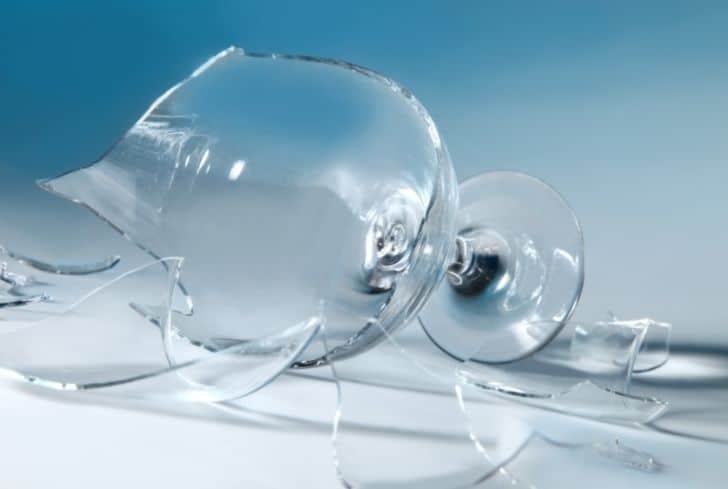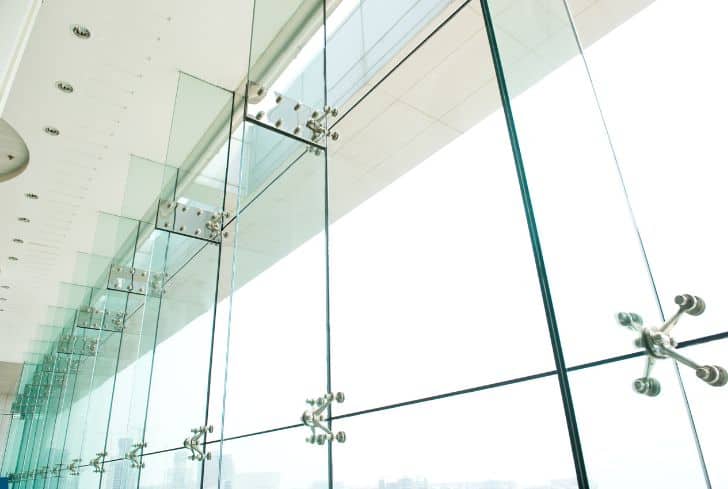Look around you – how many glass items can you identify? We bet many items around you are made of glass. Or they contain glass, i.e., your phone!
Glass has so many use cases that it is hard to envision life without it. The screen of your laptop, the back of your phone, your windows, cups, and tea mugs; glass is just about everywhere.
But let’s consider the environmental effects. If so much glass is being used yearly, what happens when a significant amount ends up in our landfills as they are famous for doing? Because believe it or not, everyone isn’t going to recycle their waste.
Is Glass Biodegradable or Nonbiodegradable?
Glass is non-biodegradable. Although it is made from natural materials like limestone, ash, and sand, it does not biodegrade. Typically, biodegradable materials are things bacteria and other microorganisms can feed on and break down to the smallest pieces for nature to re-utilize. However, there is no benefit to microbes breaking down the glass – no nutrients or pliable surface to colonize.
Glass isn’t biodegradable, but it is a sustainable option compared to plastics and other artificial materials. However, considering what glass is made of, it is little wonder this material is non-biodegradable.
Glass is liquid sand, or many people have described it that way. Have you seen sand decompose? Does sand break down?
Doubtful! Nothing is enticing or even barely nutritive for the microbes that act on organic matter to consume in glass or liquid sand. Therefore, they will not be attracted to it; you won’t return to discover colonies of bacteria or fungi surrounding the glass item.
The processing stages glass goes through also reinforce its nonbiodegradability. Melting sand sounds exciting but is not as easy as it seems. The multiple stages involved expose this resource to extreme heat, and it would take more than a horde of resilient microbes to break down the finished product.
Some glass items fall and bounce right off the carpet, and others shatter or crack. This is because some products are stronger while others are more flexible.
It depends on the heat exposure, but glass reaches a temperature where it becomes incapable of biodegradation, even if sand is capable of being broken down by microbes.
Is Broken Glass Biodegradable?
Broken glass is not biodegradable. In every processed form, glass is nonbiodegradable because of the materials it is made from and the extreme heat manufacturers expose these items to. Even when glass breaks, it does not change its non-biodegradable nature. It is still liquid or melted sand, and sand does not break down.
Glass is resilient, especially when you are holding a quality product. However, these things are also fragile and cannot hold up forever.
Furthermore, it is a no-brainer that glass cannot hold its own against brute force. Apply too much pressure, and the precious item loses form.
However, the only thing that changes about glass when it breaks is that the use cases reduce or no longer serve you for the reason you initially purchased it.
Its fundamental structure remains the same and won’t change from being melted and reinforced sand.
Have you ever seen shattered glass? Crushed glass?
Even when glass is in its littlest form, microbes like pseudomonas and mycobacterium won’t be able to break it down even when the other factors of biodegradation are present.
Broken glass is nonbiodegradable but has many redeeming features or qualities that make up for this.
Is Broken Glass Hazardous Waste?
Mostly, no. Let’s remind you that there are different applications for glass. However, glass is not hazardous waste, but if it has been transformed into products like lightbulbs or cathode ray tubes, it then becomes dangerous waste.
Hazardous Household Waste has a special or appointed disposal program. It is reserved for toxic and corrosive items you don’t need anymore.
Broken glass may or may not be inclusive, depending on what the glass was used for before it became useless. An item like a broken bulb, for instance, will qualify as hazardous waste because they are created with a mixture of gases. Some even contain substances like mercury.
On the other hand, broken glass from your favorite wine brand or your car’s windshield doesn’t count as toxic waste because it cannot rust and doesn’t contain harmful substances.
How Long Does Glass Take to Decompose?
Glass may take up to 4,000 years before decomposition occurs. This item is highly resistant to ordinary decomposition factors, especially microbes. So, it needs environmental factors and time, a long time, to break down. The same things that make glass an endearing discovery, such as its resistance to corrosion and durability, also make decomposition challenging.
In a landfill, it may take up to four thousand years before glass disappears from the area.
Glass requires extreme temperatures as high as 1700°C. This gives it a strength impenetrable strength to the factors that break down organic matter into humus.
Glass will eventually degrade, but it will take a long time. It will crush into smaller pieces that become smaller pieces until it essentially returns to where it emerged.

Can Glass be Reused?
Yes, you can reuse glass over and over. The same applies to recycling, too – glass items that are acceptable at the recycling center can be recycled repeatedly, and nothing will happen to the quality. The new product will be as mesmerizing and durable as glass ought to be. Thanks to technology, the recycled product can be ready within thirty days.
One of the best things about an item like the glass is its durability. If you are careful enough, glass products don’t wear or tear; they can last a decent period too.
You can use glass items – windows, cups, plates, and even beakers for several years if you are cautious enough. But if a slight chip or crack occurs over the years, you should recycle that material immediately. Otherwise, a broken glass item may be turned away at the recycling center because of its potential danger.
Furthermore, you should be mindful about using glass items with chips or cracks because they can hurt you.
Is Glass Bad For the Environment?
No, glass is not bad for the environment. If anything, it is the more sustainable option compared to paper or plastic. You can recycle glass items endlessly. This material is made from sand, soda ash, and limestone, and these resources are abundant. It is safe to say that despite our seemingly high glass consumption, we are not endangering the supply for the future generation.
Glass production these days is far more efficient than it used to be. Now, there is less fuel requirement, leading to controlled carbon emissions from this industry. Even when recycling occurs, the temperature does not need to be as high as it previously was.
However, there are valid arguments against the sustainability of glass, and it is right to address them.
A glass furnace must stay hot throughout the seasons and years, which certainly requires considerable energy on its own, not to talk of the carbon emissions that occur as a result.
Another argument also postulates that glass is weighty, requiring considerable fuel consumption for transportation.
However, the truth is that at the end of the day, glass is sustainable in ways that plastic and paper are not characterized for being. Not only can glass be recycled limitlessly, but it is also super durable and an excellent substitute for many products made from plastic.
It is worth mentioning that technology is striving to reduce the impact of manufacturing processes on the environment. In terms of glass manufacturing, it is safe to say that the furnace that is constantly on allows manufacturers to create when required and recycle if that is what is best.
Is Glass Better Than Plastic for the Environment?
Without a doubt, yes, glass is certainly better for the environment than plastic. The most important or noteworthy reason is that the degradation process of plastic is not friendly to the ecosystem at all! Even years after plastic breaks down, there will be microplastics in the air, soil, and water. Plastic and glass are nonbiodegradable substances, but the latter is less toxic to the environment.
Plastic also affects health. It contains carcinogens and hormone-disruptive chemicals that often make their way into the body through plastic items used for food or water.
It also doesn’t help that plastic can be found everywhere worldwide, including our water bodies like the Arctic Ocean. Unfortunately, plastic doesn’t break down or biodegrade in a friendly manner. It is even worse because some sea animals mistake plastic for food and may die from ingesting this waste.
On the other hand, glass is harmless to biodiversity. The only danger to the ecosystem from glass occurs when it is broken or cracked. Glass may also become dangerous when toxic substances have been used with or around it.
Otherwise, you are holding a piece of well-sculpted sand.
Is Glass Compostable?
No, glass is not compostable. There are several reasons why you cannot compost glass. Still, the most important one is that it lacks organic matter, which means there is nothing for factors of biodegradation to colonize. Glass is reinforced and has been heated so much that no moisture can survive such temperature, thereby discouraging microbial activity.
In addition, glass is made from sand, which is non-biodegradable. Melted and hardened and sculpted sand is still sand, and microorganisms cannot break it down, not even in its unrefined form.
As such, if you put glass in a compost pile, you will meet it precisely as you left it. If anything, it may create a hazardous scene in your compost bin or pile, not to mention rendering the entire mix useless.
You cannot compost glass, not even at the significantly high-temperature compost piles are renowned for going through.
Various Ways to Dispose of Glass
Here are some tips for disposing of glass in an environmentally conscious manner:
1. Repurpose or Upcycle Glass
This is a great way to dispose of glass because you can turn it into something else in your home. Some items we want to throw away can be repurposed for functionality or aesthetics, or both, as with the case of glass.
2. Sell It
Some companies online and offline buy used glass for resale or other profitable purposes. You can find them and get them to buy yours.
3. Recycle It
Of course, recycling is always the go-to option for materials such as this, but you may be unable to recycle broken glass.
4. Reach Out to Waste Management
When you are in a bind about how to dispose of glass, contact a waste management company in your area. They will know how to handle it.
Conclusion
Living in the glass age is fun, convenient, and easy, but we must play our role by ensuring the environment doesn’t bear the brunt of our upgraded lifestyles.






